Impact of Cooking Methods on Phenolic Acid Composition, Antioxidant Activity, and Starch Digestibility of Chinese Triticale Porridges: A Comparative Study between Atmospheric Pressure and High Pressure Boiling
Abstract
1. Introduction
2. Materials and Methods
2.1. Triticale and Chemicals
2.2. Preparation for Raw and Cooked Triticale Samples
2.3. Preparation of Triticale Flour without Lipids or/and Proteins
2.4. Extraction of Free Phenolics
2.5. Extraction of Bound Phenolics
2.6. Determination of Total Phenolic Content
2.7. Analysis of Phenolic Acid Composition
2.8. Determination of DPPH Radical Scavenging Activity
2.9. Determination of ABTS Radical Scavenging Activity
2.10. Determination of Ferric Reducing Antioxidant Power (FRAP)
2.11. Analysis of Starch Digestibility
2.11.1. Determination of Rapidly Digestible, Slowly Digestible, and Resistant Starch Contents
2.11.2. Determination of In Vitro Glycemic Index
2.12. Scanning Electron Microscopy (SEM) Analysis
2.13. X-ray Diffraction Analysis
2.14. Thermal Characteristic Analysis
2.15. Statistical Analysis
3. Results and Discussion
3.1. Free, Bound, and Total Phenolic Contents
3.2. Free and Bound Phenolic Acid Compositions
3.3. Antioxidant Activity
3.4. SEM Analysis
3.5. X-ray Diffraction and Relative Crystallinity
3.6. Thermal Properties
3.7. Starch Digestibility
4. Conclusions
Author Contributions
Funding
Institutional Review Board Statement
Informed Consent Statement
Data Availability Statement
Acknowledgments
Conflicts of Interest
References
- Aguirre, A.; Borneo, R.; León, A.E. Properties of triticale flour protein based films. LWT—Food Sci. Technol. 2011, 44, 1853–1858. [Google Scholar] [CrossRef]
- Zhu, F. Triticale: Nutritional composition and food uses. Food Chem. 2018, 241, 468–479. [Google Scholar] [CrossRef] [PubMed]
- Senol, F.S.; Kan, A.; Coksari, G.; Orhan, I.E. Antioxidant and anticholinesterase effects of frequently consumed cereal grains using in vitro test models. Int. J. Food Sci. Nutr. 2012, 63, 553–559. [Google Scholar] [CrossRef] [PubMed]
- Cai, Y.; Wang, S.; Ma, X.; Liu, H.; He, T.; Zhao, C. Effect of whole triticale flour on blood lipid level of hyperlipidemia rats. J. Hyg. Res. 2018, 47, 322–324. [Google Scholar]
- Liu, H. Regulatory Function of Whole Triticale Flour on Lipid Metabolism Disorder Rats and Hyperglycemia Mice. Master’s Thesis, Shandong University, Jinan, China, 2017. [Google Scholar]
- Chinedum, E.; Sanni, S.; Theressa, N.; Ebere, A. Effect of domestic cooking on the starch digestibility, predicted glycemic indices, polyphenol contents and alpha amylase inhibitory properties of beans (Phaseolis vulgaris) and breadfruit (Treculia africana). Int. J. Biol. Macromol. 2018, 106, 200–206. [Google Scholar] [CrossRef] [PubMed]
- Zhang, Y.; Wang, L.; Yao, Y.; Yan, J.; He, Z. Phenolic acid profiles of Chinese wheat cultivars. J. Cereal Sci. 2012, 56, 629–635. [Google Scholar] [CrossRef]
- Dykes, L.; Rooney, L.W.; Waniska, R.D.; Rooney, W.L. Phenolic compounds and antioxidant activity of sorghum grains of varying genotypes. J. Agric. Food Chem. 2005, 53, 6813–6818. [Google Scholar] [CrossRef]
- Pang, Y.; Ahmed, S.; Xu, Y.; Beta, T.; Zhu, Z.; Shao, Y.; Bao, J. Bound phenolic compounds and antioxidant properties of whole grain and bran of white, red and black rice. Food Chem. 2018, 240, 212–221. [Google Scholar] [CrossRef]
- Pradeep, P.M.; Sreerama, Y.N. Impact of processing on the phenolic profiles of small millets: Evaluation of their antioxidant and enzyme inhibitory properties associated with hyperglycemia. Food Chem. 2015, 169, 455–463. [Google Scholar] [CrossRef]
- Duodu, K.G. Effects of processing on phenolic phytochemicals in cereals and legumes. Cereal Foods World 2014, 59, 64–70. [Google Scholar] [CrossRef]
- Taylor, J.R.; Duodu, K.G. Effects of processing sorghum and millets on their phenolic phytochemicals and the implications of this to the health-enhancing properties of sorghum and millet food and beverage products. J. Sci. Food Agric. 2015, 95, 225–237. [Google Scholar] [CrossRef] [PubMed]
- Ludwig, D.S. The glycemic index: Physiological mechanisms relating to obesity, diabetes, and cardiovascular disease. JAMA 2002, 287, 2414–2423. [Google Scholar] [CrossRef] [PubMed]
- Rehman, Z.; Shah, W.H. Thermal heat processing effects on antinutrients, protein and starch digestibility of food legumes. Food Chem. 2005, 91, 327–331. [Google Scholar] [CrossRef]
- Pan, T.; Zhao, L.; Lin, L.; Wang, J.; Liu, Q.; Wei, C. Changes in kernel morphology and starch properties of high-amylose brown rice during the cooking process. Food Hydrocoll. 2017, 66, 227–236. [Google Scholar] [CrossRef]
- Wu, J.; Mcclements, D.J.; Chen, J.; Hu, X.; Liu, C. Improvement in nutritional attributes of rice using superheated steam processing. J. Funct. Foods 2016, 24, 338–350. [Google Scholar] [CrossRef]
- Statistics Division of Food and Agriculture Organization of the United Nations. Available online: http://www.fao.org/faostat/en/#data/QC/visualize (accessed on 16 August 2021).
- Ye, J.; Hu, X.; Luo, S.; Mcclements, D.J.; Liang, L.; Liu, C. Effect of endogenous proteins and lipids on starch digestibility in rice flour. Food Res. Int. 2018, 106, 404–409. [Google Scholar] [CrossRef]
- Tian, S.; Nakamura, K.; Cui, T.; Kayahara, H. High-performance liquid chromatographic determination of phenolic compounds in rice. J. Chromatogr. A 2005, 1063, 121–128. [Google Scholar] [CrossRef]
- Zieliński, H.; Kozlowska, H.; Lewczuk, B. Bioactive compounds in the cereal grains before and after hydrothermal processing. Innov. Food Sci. Emerg. Technol. 2001, 2, 159–169. [Google Scholar] [CrossRef]
- Kubola, J.; Siriamornpun, S.; Meeso, N. Phytochemicals, vitamin C and sugar content of Thai wild fruits. Food Chem. 2011, 126, 972–981. [Google Scholar] [CrossRef]
- Irakli, M.N.; Samanidou, V.F.; Biliaderis, C.G.; Papadoyannis, I.N. Development and validation of an HPLC-method for determination of free and bound phenolic acids in cereals after solid-phase extraction. Food Chem. 2012, 134, 1624–1632. [Google Scholar] [CrossRef]
- Mareček, V.; Mikyška, A.; Hampel, D.; Čejka, P.; Neuwirthová, J.; Malachová, A.; Cerkal, R. ABTS and DPPH methods as a tool for studying antioxidant capacity of spring barley and malt. J. Cereal Sci. 2017, 73, 40–45. [Google Scholar] [CrossRef]
- Englyst, H.N.; Kingman, S.M.; Cummings, J.H. Classification and measurement of nutritionally important starch fractions. Eur. J. Clin. Nutr. 1992, 46, S33–S50. [Google Scholar] [PubMed]
- Goñi, I.; Garcia-Alonso, A.; Saura-Calixto, F. A starch hydrolysis procedure to estimate glycemic index. Nutr. Res. 1997, 17, 427–437. [Google Scholar] [CrossRef]
- Gan, R.; Sui, Z.; Yang, Q.; Corke, H. Enhancement of antioxidant capacity and phenolic content in soluble and bound extracts of germinated black wheat. J. Shanghai Jiaotong Univ. Agric. Sci. 2017, 35, 1–10. [Google Scholar] [CrossRef]
- Scaglioni, P.T.; De Souza, T.D.; Schmidt, C.G.; Badiale-Furlong, E. Availability of free and bound phenolic compounds in rice after hydrothermal treatment. J. Cereal Sci. 2014, 60, 526–532. [Google Scholar] [CrossRef]
- Bryngelsson, S.; Dimberg, L.H.; Kamal-Eldin, A. Effects of commercial processing on levels of antioxidants in oats (Avena sativa L.). J. Agric. Food Chem. 2002, 50, 1890–1896. [Google Scholar] [CrossRef] [PubMed]
- Dona, A.M. Enhancing Antioxidant Activity and Extractability of Bioactive Compounds of Wheat Bran Using Thermal Treatments. Master’s Thesis, University of Manitoba, Winnipeg, MB, Canada, 2011. [Google Scholar]
- Guo, Y. Study on the Functional Characteristics and Application of Air Expanded Triticale Bran. Master’s Thesis, Northwest A & F University, Yangling, China, 2018. [Google Scholar]
- Zhang, M.; Chen, H.; Li, J.; Pei, Y.; Liang, Y. Antioxidant properties of tartary buckwheat extracts as affected by different thermal processing methods. LWT-Food Sci. Technol. 2010, 43, 181–185. [Google Scholar] [CrossRef]
- Şensoy, Í.; Rosen, R.T.; Ho, C.; Karwe, M.V. Effect of processing on buckwheat phenolics and antioxidant activity. Food Chem. 2006, 99, 388–393. [Google Scholar] [CrossRef]
- Adom, K.K.; Liu, R.H. Antioxidant activity of grains. J. Agric. Food Chem. 2002, 50, 6182–6187. [Google Scholar] [CrossRef]
- Parker, M.L.; Ng, A.; Waldron, K.W. The phenolic acid and polysaccharide composition of cell walls of bran layers of mature wheat (Triticum aestivum L. cv. Avalon) grains. J. Sci. Food Agric. 2005, 85, 2539–2547. [Google Scholar] [CrossRef]
- Weidner, S.; Amarowicz, R.; Karamać, M.; Dąbrowski, G. Phenolic acids in caryopses of two cultivars of wheat, rye and triticale that display different resistance to pre-harvest sprouting. Eur. Food Res. Technol. 1999, 210, 109–113. [Google Scholar] [CrossRef]
- Abdel-Aal, E.S.M.; Choo, T.M.; Dhillon, S.; Rabalski, I. Free and bound phenolic acids and total phenolics in black, blue, and yellow barley and their contribution to free radical scavenging capacity. Cereal Chem. 2012, 89, 198–204. [Google Scholar] [CrossRef]
- Acosta-Estrada, B.A.; Gutiérrez-Uribe, J.A.; Serna-Saldívar, S.O. Bound phenolics in foods, a review. Food Chem. 2014, 152, 46–55. [Google Scholar] [CrossRef]
- Chandrasekara, A.; Shahidi, F. Bioactivities and antiradical properties of millet grains and hulls. J. Agric. Food Chem. 2011, 59, 9563–9571. [Google Scholar] [CrossRef] [PubMed]
- Liu, R.H. Whole grain phytochemicals and health. J. Cereal Sci. 2007, 46, 207–219. [Google Scholar] [CrossRef]
- Masisi, K.; Beta, T.; Moghadasian, M.H. Antioxidant properties of diverse cereal grains: A review on in vitro and in vivo studies. Food Chem. 2016, 196, 90–97. [Google Scholar] [CrossRef]
- Sumczynski, D.; Bubelova, Z.; Sneyd, J.; Erb-Weber, S.; Mlcek, J. Total phenolics, flavonoids, antioxidant activity, crude fibre and digestibility in non-traditional wheat flakes and muesli. Food Chem. 2015, 174, 319–325. [Google Scholar] [CrossRef] [PubMed]
- Chandrasekara, A.; Naczk, M.; Shahidi, F. Effect of processing on the antioxidant activity of millet grains. Food Chem. 2012, 133, 1–9. [Google Scholar] [CrossRef]
- Ma, Z.; Boye, J.I.; Simpson, B.K.; Prasher, S.O.; Monpetit, D.; Malcolmson, L. Thermal processing effects on the functional properties and microstructure of lentil, chickpea, and pea flours. Food Res. Int. 2011, 44, 2534–2544. [Google Scholar] [CrossRef]
- Kandil, A.; Li, J.; Vasanthan, T.; Bressler, D.C.; Tyler, R.T. Compositional changes in whole grain flours as a result of solvent washing and their effect on starch amylolysis. Food Res. Int. 2011, 44, 167–173. [Google Scholar] [CrossRef]
- Zobel, H.F. Starch crystal transformations and their industrial importance. Starch-Stärke 1988, 40, 1–7. [Google Scholar] [CrossRef]
- Cruz, B.R.; Abraão, A.S.; Lemos, A.M.; Nunes, F.M. Chemical composition and functional properties of native chestnut starch (Castanea sativa Mill). Carbohydr. Polym. 2013, 94, 594–602. [Google Scholar] [CrossRef]
- Benmoussa, M.; Suhendra, B.; Aboubacar, A.; Hamaker, B.R. Distinctive sorghum starch granule morphologies appear to improve raw starch digestibility. Starch-Stärke 2006, 58, 92–99. [Google Scholar] [CrossRef]
- Hoover, R.; Sosulski, F. Studies on the functional characteristics and digestibility of starches from Phaseolus vulgaris biotypes. Starch-Stärke 1985, 37, 181–191. [Google Scholar] [CrossRef]
- Kan, L.; Li, Q.; Xie, S.; Hu, J.; Wu, Y.; Ouyang, J. Effect of thermal processing on the physicochemical properties of chestnut starch and textural profile of chestnut kernel. Carbohydr. Polym. 2016, 151, 614–623. [Google Scholar] [CrossRef]
- Chung, H.J.; Cho, D.W.; Park, J.D.; Kweon, D.K.; Lim, S.T. In vitro starch digestibility and pasting properties of germinated brown rice after hydrothermal treatments. J. Cereal Sci. 2012, 56, 451–456. [Google Scholar] [CrossRef]
- Watcharatewinkul, Y.; Puttanlek, C.; Rungsardthong, V.; Uttapap, D. Pasting properties of a heat-moisture treated canna starch in relation to its structural characteristics. Carbohydr. Polym. 2009, 75, 505–511. [Google Scholar] [CrossRef]
- Jayakody, L.; Lan, H.; Hoover, R.; Chang, P.; Liu, Q.; Donner, E. Composition, molecular structure and physicochemical properties of starches from two grass pea (Lathyrus sativus L.) cultivars grown in Canada. Food Chem. 2007, 105, 116–125. [Google Scholar] [CrossRef]
- Ovando-Martínez, M.; Osorio-Díaz, P.; Whitney, K.; Bello-Pérez, L.A.; Simsek, S. Effect of the cooking on physicochemical and starch digestibility properties of two varieties of common bean (Phaseolus vulgaris L.) grown under different water regimes. Food Chem. 2011, 129, 358–365. [Google Scholar] [CrossRef]
- Chung, H.J.; Liu, Q.; Hoover, R. Impact of annealing and heat-moisture treatment on rapidly digestible, slowly digestible and resistant starch levels in native and gelatinized corn, pea and lentil starches. Carbohydr. Polym. 2009, 75, 436–447. [Google Scholar] [CrossRef]
- Li, H.; Wang, R.; Liu, J.; Zhang, Q.; Li, G.; Shan, Y.; Ding, S. Effects of heat-moisture and acid treatments on the structural, physicochemical, and in vitro digestibility properties of lily starch. Int. J. Biol. Macromol. 2020, 148, 956–968. [Google Scholar] [CrossRef]
- He, M.; Qiu, C.; Liao, Z.; Sui, Z.; Corke, H. Impact of cooking conditions on the properties of rice: Combined temperature and cooking time. Int. J. Biol. Macromol. 2018, 117, 87–94. [Google Scholar] [CrossRef]
- Giuberti, G.; Gallo, A.; Cerioli, C.; Masoero, F. In vitro starch digestion and predicted glycemic index of cereal grains commonly utilized in pig nutrition. Anim. Feed Sci. Technol. 2012, 174, 163–173. [Google Scholar] [CrossRef]
- López-Barón, N.; Gu, Y.; Vasanthan, T.; Hoover, R. Plant proteins mitigate in vitro wheat starch digestibility. Food Hydrocoll. 2017, 69, 19–27. [Google Scholar] [CrossRef]
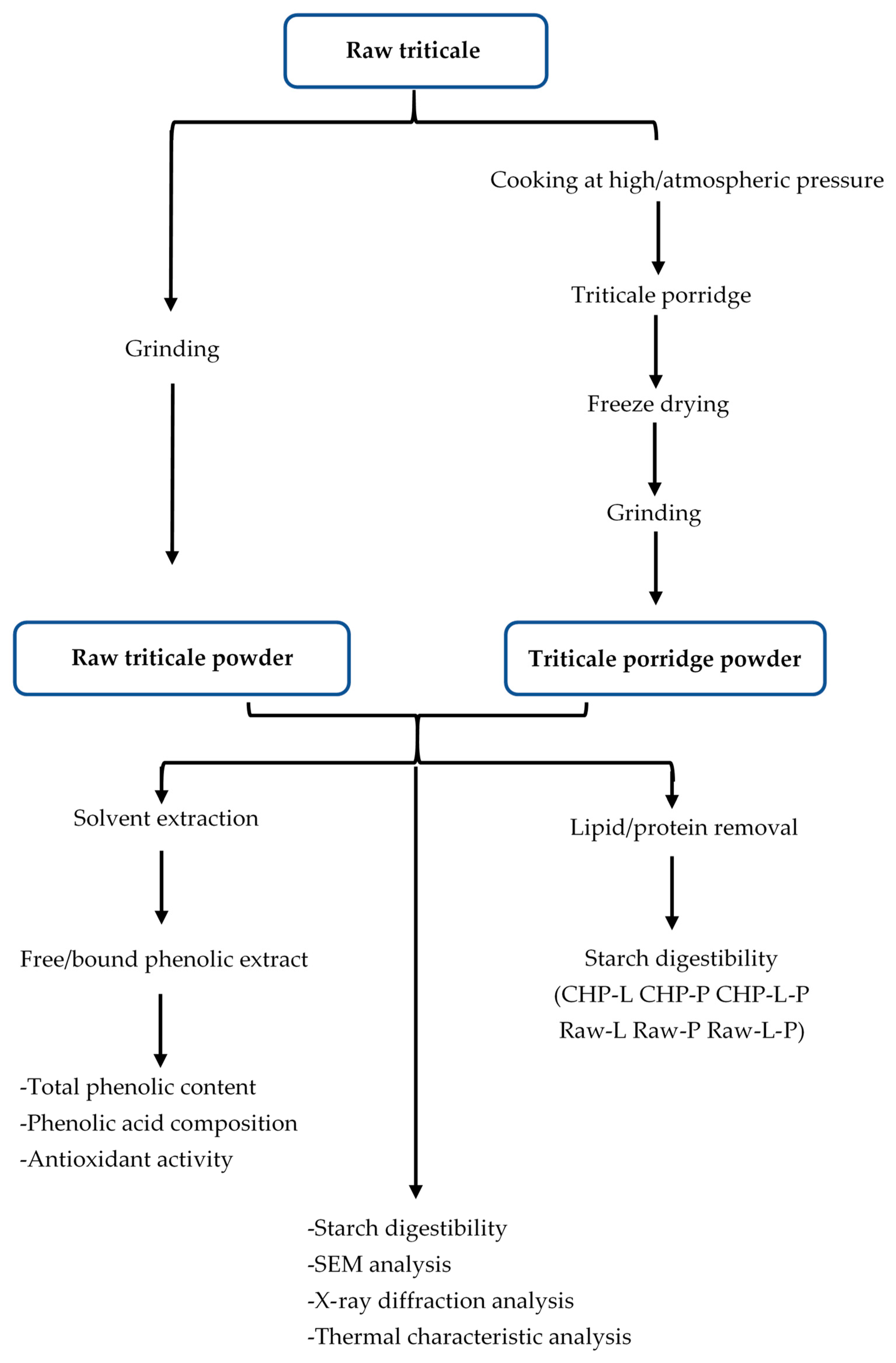
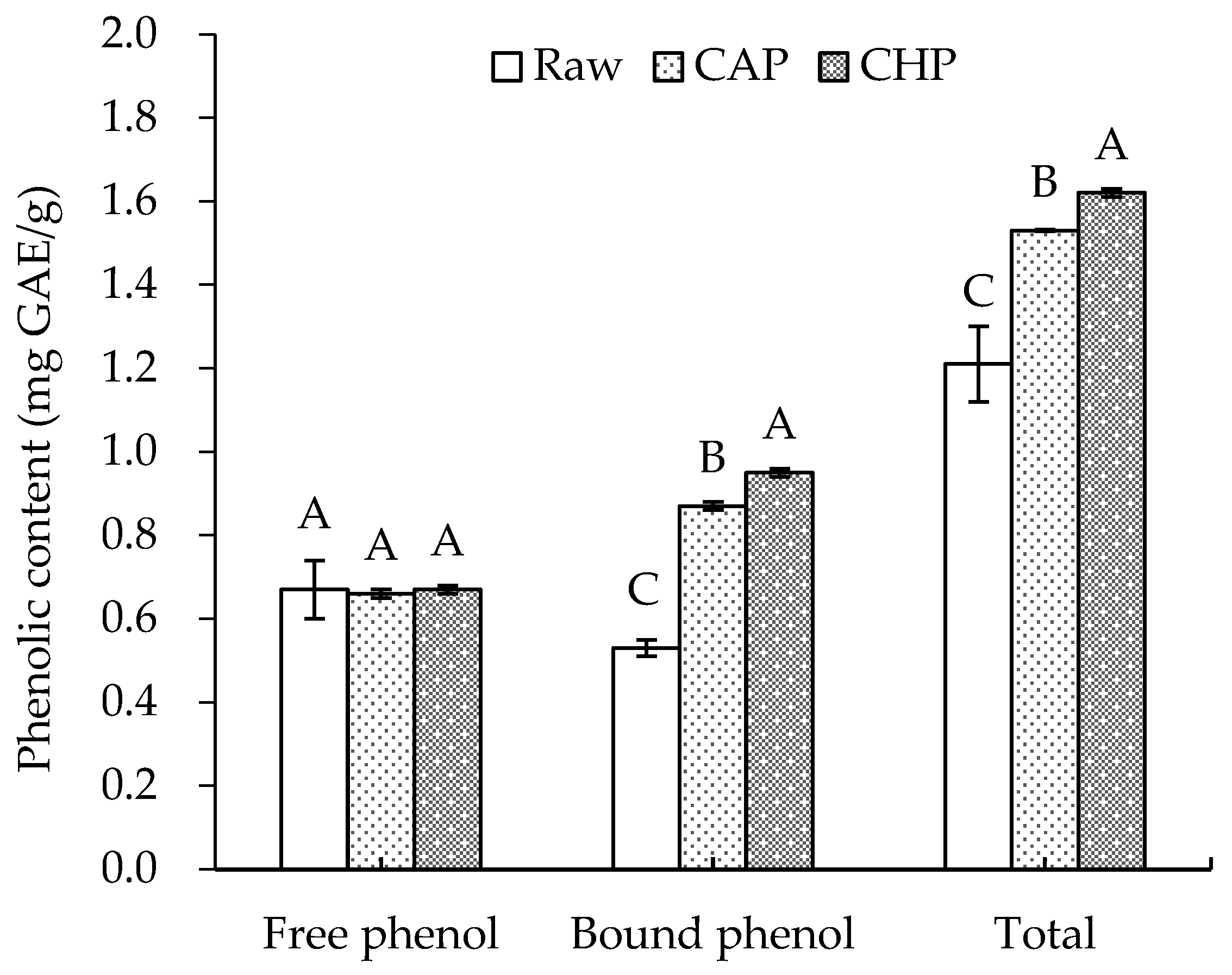
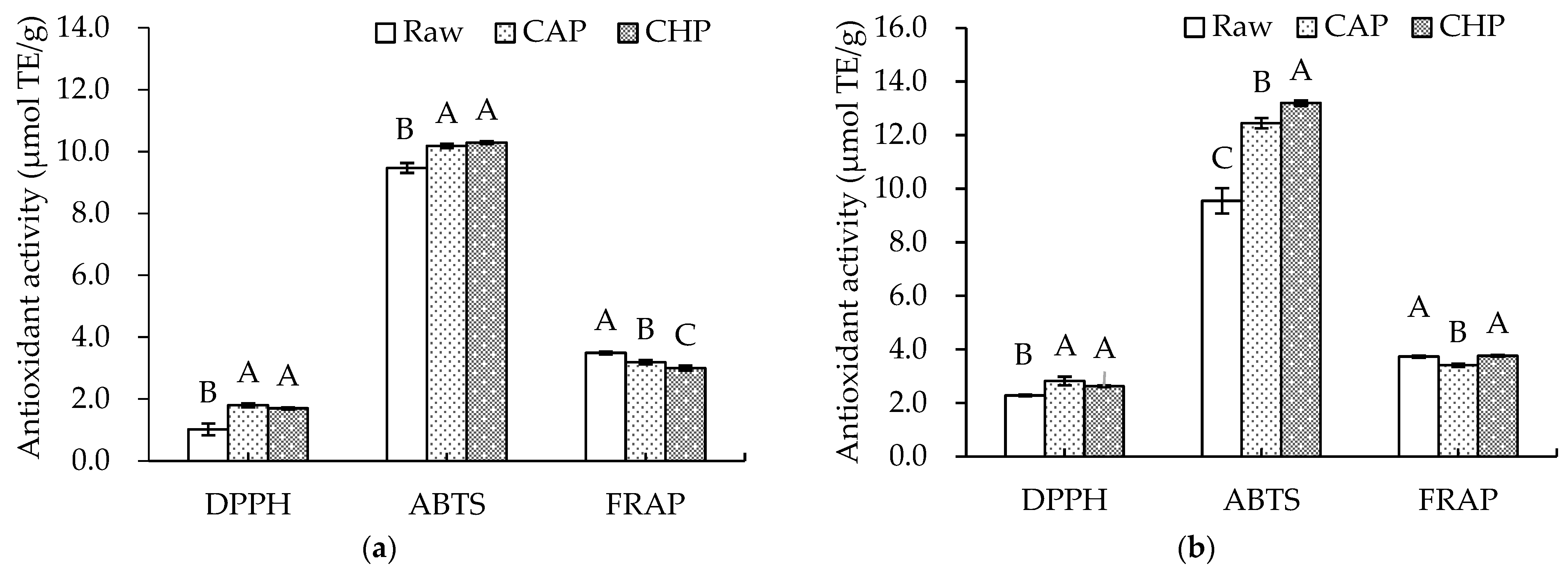

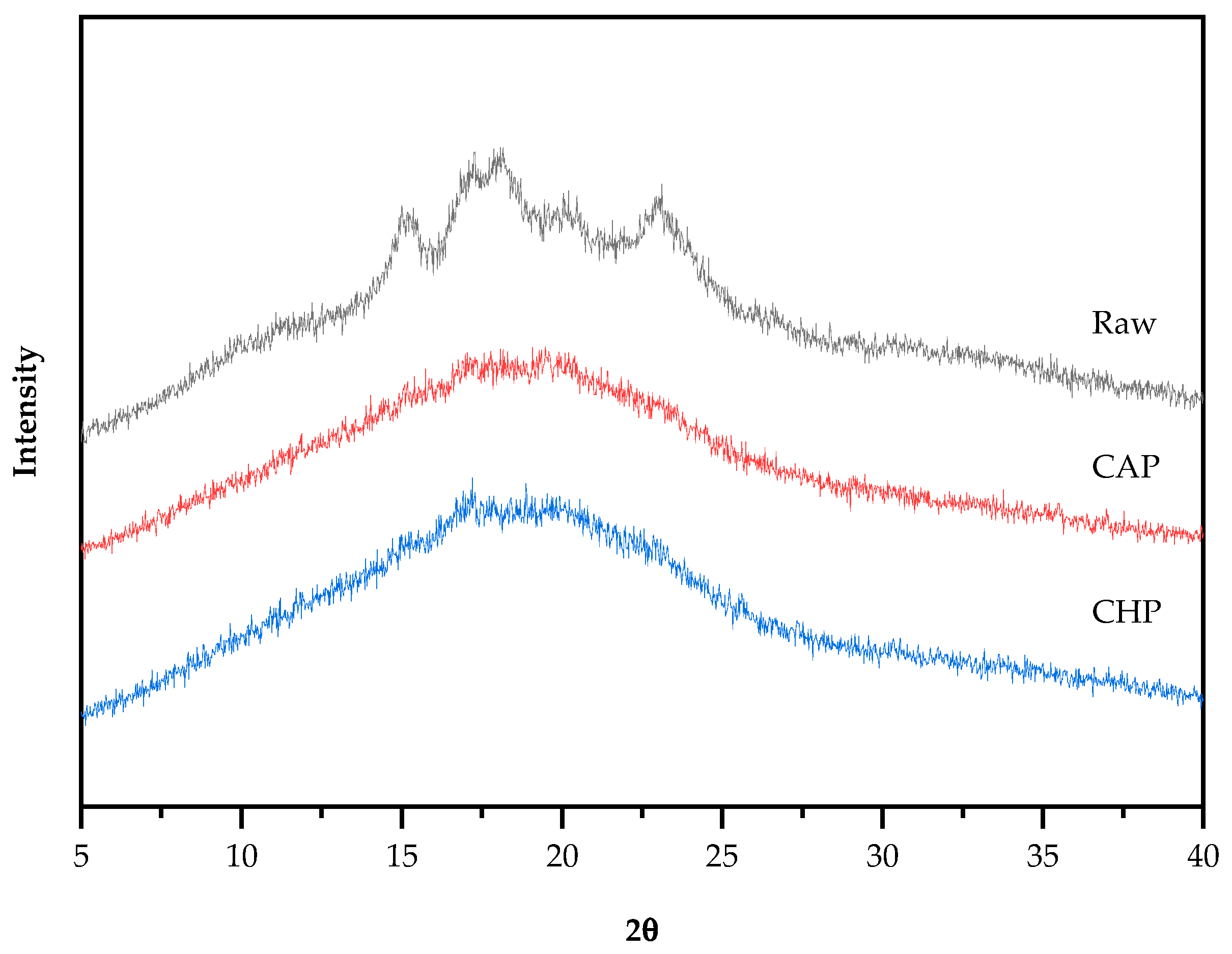
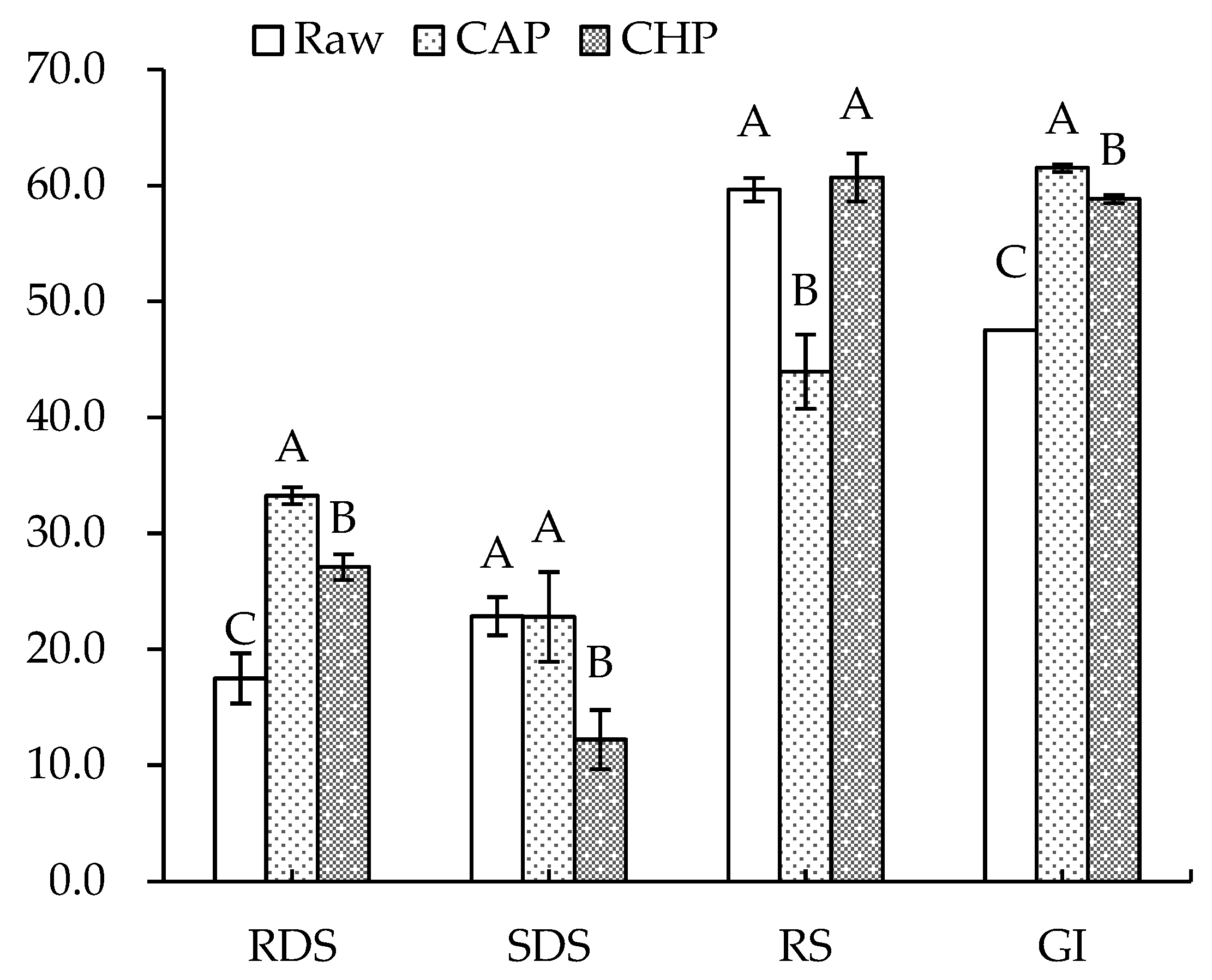

| Compound | Treatment | Free | Bound |
|---|---|---|---|
| Protocatechuic acid | Raw | 3.33 ± 0.21 C | 5.65 ± 0.69 A |
| CAP | 7.57 ± 0.40 A | 2.80 ± 0.24 C | |
| CHP | 6.08 ± 0.10 B | 3.86 ± 0.27 B | |
| p-hydroxybenzoic acid | Raw | 1.90 ± 0.07 B | 2.70 ± 0.35 A |
| CAP | 2.42 ± 0.18 A | 1.23 ± 0.10 C | |
| CHP | 2.63 ± 0.08 A | 1.86 ± 0.09 B | |
| Vanillic acid | Raw | 5.02 ± 0.50 C | 19.41 ± 1.93 A |
| CAP | 7.85 ± 0.28 B | 10.32 ± 0.58 C | |
| CHP | 9.10 ± 0.24 A | 12.83 ± 0.19 B | |
| t-Cinnamic acid | Raw | 18.16 ± 0.16 | — |
| CAP | — | 0.28 ± 0.02 B | |
| CHP | — | 0.39 ± 0.02 A | |
| Gallic acid | Raw | — | — |
| CAP | — | — | |
| CHP | 14.34 ± 0.72 | — | |
| Syringic acid | Raw | 1.99 ± 0.21 B | 5.95 ± 0.11 A |
| CAP | 3.17 ± 0.41 A | 4.11 ± 0.31 B | |
| CHP | 2.14 ± 0.17 B | 4.67 ± 0.42 B | |
| Caffeic acid | Raw | 1.36 ± 0.18 A | 8.43 ± 0.11 |
| CAP | — | — | |
| CHP | 0.15 ± 0.02 B | — | |
| p-Coumaric acid | Raw | 3.75 ± 0.09 A | 15.94 ± 0.32 A |
| CAP | 0.59 ± 0.05 B | — | |
| CHP | 0.59 ± 0.04 B | 3.21 ± 0.19 B | |
| Ferulic acid | Raw | 6.85 ± 0.03 B | 782.49 ± 1.30 A |
| CAP | 10.46 ± 1.03 A | 247.82 ± 4.83 C | |
| CHP | 9.72 ± 0.21 A | 409.26 ± 3.16 B | |
| Sinapic acid | Raw | 0.62 ± 0.05 C | 27.54 ± 0.49 A |
| CAP | 4.81 ± 0.42 A | 17.96 ± 0.40 B | |
| CHP | 4.05 ± 0.19 B | 18.04 ± 1.05 B | |
| Total | Raw | 42.96 ± 1.18 B | 868.11 ± 4.86 A |
| CAP | 36.88 ± 2.10 C | 284.52 ± 4.56 C | |
| CHP | 48.79 ± 1.07 A | 454.12 ± 4.42 B |
| Treatment | Relative Crystallinity | Thermal Characteristics | ||||
|---|---|---|---|---|---|---|
| To (°C) | Tp (°C) | Tc (°C) | Tc–To (°C) | ∆H (J/g) | ||
| Raw | 11.47 ± 0.15 A | 65.21 ± 0.12 A | 71.10 ± 0.87 A | 70.11 ± 0.12 A | 4.89 ± 0.09 C | 5.61 ± 0.03 A |
| CAP | 4.97 ± 0.23 B | 48.14 ± 0.09 C | 51.45 ± 0.10 B | 58.94 ± 0.05 B | 10.80 ± 0.11 A | 1.86 ± 0.14 C |
| CHP | 5.27 ± 0.06 B | 48.92 ± 0.59 B | 51.46 ± 0.09 B | 56.63 ± 0.14 C | 7.71 ± 0.62 B | 2.22 ± 0.11 B |
Disclaimer/Publisher’s Note: The statements, opinions and data contained in all publications are solely those of the individual author(s) and contributor(s) and not of MDPI and/or the editor(s). MDPI and/or the editor(s) disclaim responsibility for any injury to people or property resulting from any ideas, methods, instructions or products referred to in the content. |
© 2024 by the authors. Licensee MDPI, Basel, Switzerland. This article is an open access article distributed under the terms and conditions of the Creative Commons Attribution (CC BY) license (https://creativecommons.org/licenses/by/4.0/).
Share and Cite
Li, H.; Mao, Y.; Ma, D.; Li, H.; Liu, R.; Siriamornpun, S. Impact of Cooking Methods on Phenolic Acid Composition, Antioxidant Activity, and Starch Digestibility of Chinese Triticale Porridges: A Comparative Study between Atmospheric Pressure and High Pressure Boiling. Foods 2024, 13, 230. https://doi.org/10.3390/foods13020230
Li H, Mao Y, Ma D, Li H, Liu R, Siriamornpun S. Impact of Cooking Methods on Phenolic Acid Composition, Antioxidant Activity, and Starch Digestibility of Chinese Triticale Porridges: A Comparative Study between Atmospheric Pressure and High Pressure Boiling. Foods. 2024; 13(2):230. https://doi.org/10.3390/foods13020230
Chicago/Turabian StyleLi, Hua, Yurong Mao, Danni Ma, Hua Li, Ruixin Liu, and Sirithon Siriamornpun. 2024. "Impact of Cooking Methods on Phenolic Acid Composition, Antioxidant Activity, and Starch Digestibility of Chinese Triticale Porridges: A Comparative Study between Atmospheric Pressure and High Pressure Boiling" Foods 13, no. 2: 230. https://doi.org/10.3390/foods13020230
APA StyleLi, H., Mao, Y., Ma, D., Li, H., Liu, R., & Siriamornpun, S. (2024). Impact of Cooking Methods on Phenolic Acid Composition, Antioxidant Activity, and Starch Digestibility of Chinese Triticale Porridges: A Comparative Study between Atmospheric Pressure and High Pressure Boiling. Foods, 13(2), 230. https://doi.org/10.3390/foods13020230






